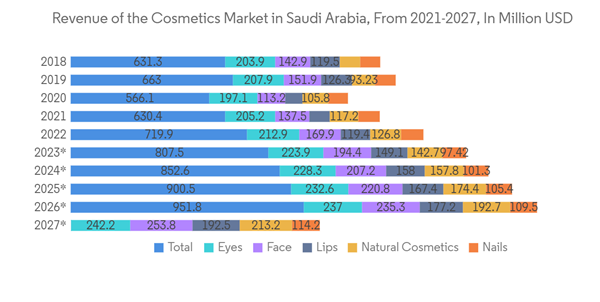Dublin, March 25, 2024 (GLOBE NEWSWIRE) -- The "Saudi Arabia Chemical Logistics - Market Share Analysis, Industry Trends & Statistics, Growth Forecasts 2020 - 2029" report has been added to ResearchAndMarkets.com's offering.
The Saudi Arabia Chemical Logistics Market size is estimated at USD 10.64 billion in 2024, and is expected to reach USD 14.27 billion by 2029, growing at a CAGR of greater than 6.12% during the forecast period (2024-2029).
Chemical firms from the Gulf Cooperation Council (GCC) should be more robust to rising borrowing and energy prices than their bigger European competitors. In light of the current stresses of rising interest rates and higher energy costs, GCC chemical companies are likely to be more resilient than international peers due to low feedstock prices, long-term supply security, and solid customer and shareholder bases (75%-80% of GCC chemical companies' revenue).
Saudi Arabia's logistics business is worth USD 18 billion by 2022 and its services are extended internationally. The country's substantial transport activity heavily supports Saudi Arabia's economy. Furthermore, the Kingdom of Saudi Arabia (KSA) has implemented several economic reforms in the industry, hastening its progress towards its development program 'Vision 2030.' The program calls for strengthening the Saudi economy by relying less on oil and focusing more on logistics, health, education, and infrastructure, among other things.
Saudi Arabia's freight network is enormous, with an estimated 40,000 vehicles operating in eight countries throughout the Middle East and Central Asia. The ministry oversees a network of 71,500 km of paved roads, 5000 km of which are motorways and 49,000 km of which are single-lane roads. There are also 144,000 km of improved dirt roads. To improve road safety, the ministry has rolled out automated voice-warning signs on 58 km of roads, alerting drivers who veer outside lane markers, use mobile phones, or are driving in inclement weather.
The projected GCC railway, a USD 15.5 billion project that will connect the six nations with a network of 2172 km of track, will handle up to 29 million tonnes of the total 61 million transferred within the area yearly across all modes of transport (see study). It is also projected to help the Kingdom handle its sustainability concerns by reducing CO emissions by 70% to 80% as compared to trucks. According to studies, the project may reduce container and bulk freight costs by up to 30% while also creating up to 80,000 employees. It may also help to clear the shipping lane via the congested Strait of Hormuz.
In 2022 Al Jasser, as minister of transport and logistic services, signed two memoranda of understanding with Jean-Baptiste Djebbari, France's minister of transport, to collaborate on rail and other upcoming logistics innovations.
As of February 2022, the primary entry point for imports is Jeddah Islamic Port (JIP), which accounts for 26.7% of the total. Because of its location on the Red Sea, Saudi Arabia's west coast serves as the principal entrance point for containers, while its east coast ports serve as the key loading point for energy exports. While JIP is the busiest commercial port, the two King Fahad Industrial Ports - one on the Red Sea and one on the Gulf - remain the busiest industrial ports due to their significance to the petroleum sector.
The construction, which will be completed in 2024 by Dubai Port World (DP World), will increase capacity from 2.4 million TEUs to 3.6 million TEUs. In June 2022, DP World inked a 30-year concession deal with JIP for the building of a logistics park for SR500 million (USD 133.3 million). The 415,000-square-metre facility will feature a container depot capacity of roughly 250,000 TEUs and 100,000 square meters of warehouse storage space.
Saudi Arabia Chemical Logistics Market Trends
The Rise in Chemical Production is Expected to Propel the Growth of the Chemical Logistics Market
The region's larger chemical companies benefit in general from competitively low feedstock prices, which are priced at significant discounts to the European benchmark, the Dutch TTF, which briefly exceeded USD 70 per million British thermal units (mmbtu) in mid-August 2022, compared to USD 25/mmbtu at the beginning of June 2022 and USD 18/mmbtu at the end of 2021. Saudi Arabia, for example, kept methane and ethane prices stable at USD 1.25 and USD 1.75/mmbtu, respectively. When combined with a strong consumer and shareholder base, the GCC players' profitability outperforms their European counterparts.
Higher commodity prices (particularly natural gas) benefit commodity players in the GCC. This is shown in their comparatively excellent performance in 2021 and their rather resilient first-half performance in 2022. Overall market expectations are for publicly traded chemical companies to maintain healthy unadjusted EBITDA margins of around 30% in 2022, compared to 34%-35% in 2021, despite some margin softening this year due to global capacity additions outpacing demand in some segments and high inventory levels.
Furthermore, national oil companies are investing in the development of gas fields to increase gas production, which aids in the provision of raw materials for electricity and petrochemical production. In particular, Saudi Aramco announced in March 2022, as part of its long-term strategy, that it is considering potentially increasing gas production by 50% by 2030 and is investing to increase gas production for electricity and petrochemical production by developing gas fields unrelated to oil production.
For more information about this report visit https://www.researchandmarkets.com/r/5uhl2q
About ResearchAndMarkets.com
ResearchAndMarkets.com is the world's leading source for international market research reports and market data. We provide you with the latest data on international and regional markets, key industries, the top companies, new products and the latest trends.
Attachment
